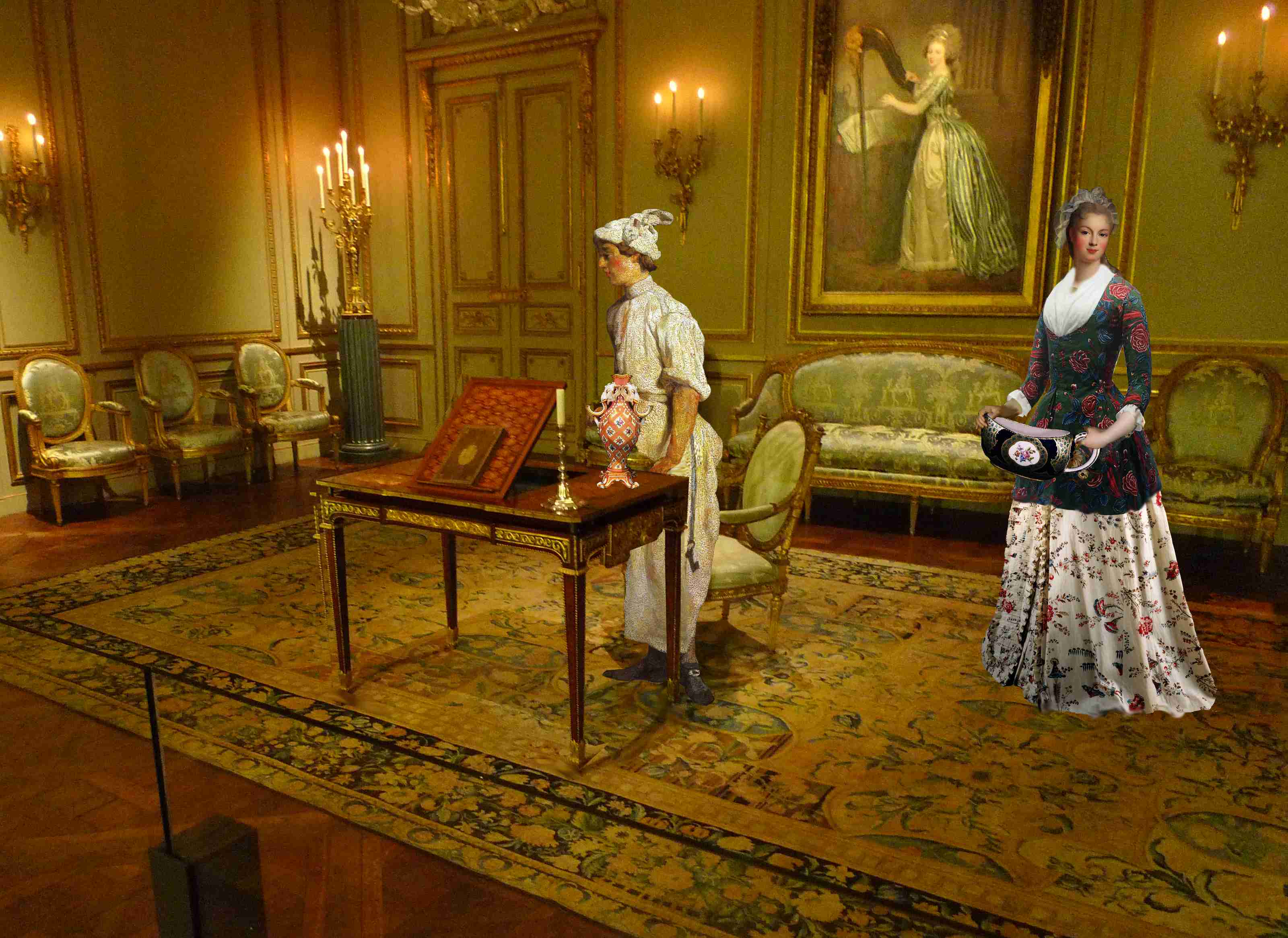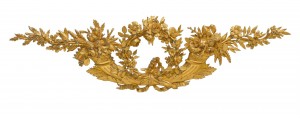AT WORK
Male servants were not uncommon in France during the eighteenth century. However, despite their presence in eighteenth century French history, they are not often represented in art. This male servant comes from a 1738 painting entitled “The Waiter” by renowned French artist Jean-Baptiste Siméon Chardin. In the painting from which this image was selected the male servant appears to perform one of his daily tasks by pouring a liquid into a large basin. However, within the Tessé Room, the male servant is placed by the mechanical Riesener table. Here, he opens various compartments, making sure to remove any dust for his owner.
The female servant in the Tessé Room, constructed from various paintings and costumes in the Metropolitan Museum’s collection, perfectly exemplifies the second-hand clothing trade market in eighteenth century Paris. This booming market was an essential part of Parisian history, demonstrating the power of illusion of luxury and self-invention. The Parisian upper-class created a thriving consumption economy which lower-classes, particularly servants, had the ability to access indirectly. Through this new economy, people with less means had the ability to transform themselves, creating an illusion of wealth and glamour in their everyday lives. Here, the female servant carries a beautifully ornate chamber pot, created by the same porcelain company as the vase that lies on the desk, the Sèvres Manufactory.
Caraco
Dutch, second half of the 18th century
Cotton
The Metropolitan Museum of Art, New York
Dimensions: Length at CB: 26 in. (66 cm)
Purchase, Gifts from various donors, 2000
2000.251
Not on view
This green floral-patterned caraco originates from the Netherlands but copies French fashion trends of the time. It was not abnormal that servants would wear fine, exquisite or intricately patterned costumes or second-hand “knock-offs” of the original. As mentioned above, the second-hand market in Paris boomed during the eighteenth century, which demonstrated both a physical and mental shift regarding dress and self-presentation. Regardless of socioeconomic class, Parisians could present themselves in an elegant manner at any price point.
Robe à la française
Third quarter of 18th century, France
Ivory cotton printed in multicolored floral motif
The Metropolitan Museum of Art, New York
Purchase, Irene Lewisohn Bequest, 1964
C.I.64.32a, b
Not on view
The servant’s dress, worn underneath the jacket, is called “robe à la française,” which simply translates to, “French dress” or “dress in the French style.” Though the dress is styled in a traditionally French manner, the influence of chinoiserie, and the global exchange between France and the Orient, cannot be ignored. France was heavily influenced artistically by China and Japan: most notably in their attempts to duplicate pure white porcelain and lacquered objects.
Vase (Vase à tête d’elephant) (one of a pair)
Sèvres Manufactory (French, 1740–present)
Modeler: Jean-Claude Duplessis (ca. 1695–1774, active 1748–74)
ca. 1758
French, Sèvres
Soft-paste porcelain
Overall (confirmed): 15 7/16 × 10 5/16 × 6 1/4 in., 6lb. (39.2 × 26.2 × 15.9 cm, 2.7443kg)
Gift of Samuel H. Kress Foundation, 1958
58.75.91a, b
This vase, known as “ vase à tête d’elephant,” is one of a set of two, modeled by the renowned modeler Jean-Claude Duplessis at the Sèvres Manufactory. This pink, soft-paste porcelain dates to around 1758 exemplifies the Baroque style that was in-fashion during this era. In addition, the sculptural aspect of the elephant recalls the Orient, of countries like China and Japan, where porcelain originated.
This object can be viewed in Gallery 529 in the European Sculptures and Decorative Arts (ESDA) Collection in the Metropolitan Museum of Art.
Chamber Pot (Pot de chambre ovale)
Sèvres Manufactory (French, 1740–present)
1757–58
French, Sèvres
Soft-paste porcelain
Dimensions: Gr. H. 3 5/8 in. (9.2 cm.); Gr. L. 7 5/8 in. (19.4 cm.)
Bequest of R. Thornton Wilson, in memory of his wife, Florence Ellsworth Wilson, 1977
1977.216.46
This “pot de chambre ovale,” or chamber pot, would have been used as a type of toilet by those in the upper tier of the French elite. Like the elephant vase, this soft-paste porcelain pot was made in the renowned Sèvres Manufactory, located in Vincennes, a few miles east of Paris. This object dates to ca. 1757-58 and can be found in the Metropolitan Museum of Art’s European Sculpture and Decorative Arts collection in Gallery 523.

